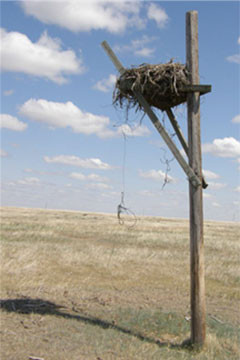Government mail service may be affected by the Canada Post labour disruption. Learn about how critical government mail will be handled.
See event listings and more articles in this edition of Agri-News: April 19, 2022 issue
“Controlling Richardson’s Ground Squirrels (RGSs) can be challenging in any year,” says Karen Wickerson, rat and pest program specialist with the Alberta government. “Timing is the key to efficient control. April is generally the best month for controlling RGSs as they emerge earlier or later in the spring depending on the amount of snow. Control should be initiated prior to the emergence of the young when the males first emerge above ground and before the females go underground to have their litters.”
Options for control include shooting, use of rodenticides and non-chemical means. These options are all part of an Integrated Pest Management approach which includes a combination of methods to control the nuisance rodent.
Shooting
Shooting is a very effective method for control, especially when the males first emerge as they are living off their winter body fat and fighting for territories. The females emerge two weeks after the males and breed immediately.
“Targeting the breeding males and females can have a significant reduction in the population of RGSs in any given year,” says Wickerson.
Rodenticides
There are rodenticides labelled to control RGSs; however, misuse of these products may result in non target poisonings. Strychnine is the best known product as it is a single feeding product; the registration for use of this product will be ending March 4, 2023 by Health Canada.
Rozol® (Chlorophacinone) is an effective product that is an anti-coagulant and requires multiple feedings. Ramik Green® (Diphacinone) is another multi-feeding anticoagulant. Zinc phosphide is a different type of single feeding product acting differently in the body than strychnine resulting in lower secondary poisonings.
“The key is to put the rodenticides out after mating and before crops emerge as RGSs will choose a fresh crop over grain. Check with your local agricultural fieldman to see if these products may be suitable for you.”
Non-chemical controls
There are a variety of non-chemical controls that can be used without the risk of secondary poisonings. Platforms for raptors in treeless areas encourage them to nest and should be set up for a period of time before nesting to allow the raptors to become familiar with them. They can be as simple as two large round bales set on end with one on top of the other, or a more permanent structure as seen below.
“One pair of nesting ferruginous hawks can consume up to 500 RGSs in a season. The local electricity distributor in your area may have a program to provide poles for constructing platforms.”

How to construct a platform: Ferruginous Hawk Artificial Nest Platforms Brochure
Other options for non-chemical control include cultivating fields to destroy burrows and mounds. Leaving field margins tall to allow for predators such as foxes to den and leave grass tall on fence lines for coyotes and weasels to hunt RSGs. Rotating crops, cleaning up spilled grain, and removing hiding places such as boards or garbage can be effective.
“There is no one effective control for Richardson’s Ground Squirrels. A multi-pronged approach must be taken every year incorporating different methods of control,” says Wickerson.
Contact
For more information, connect with Karen Wickerson at 403-948-3999.
Sign up for Agri-News
Start every Monday with the week’s top agricultural stories and latest updates.
Read about all things agriculture at Alberta.ca/agri-news